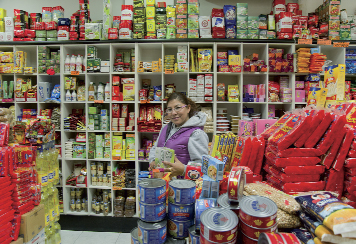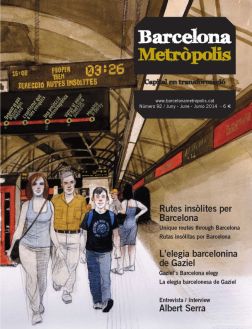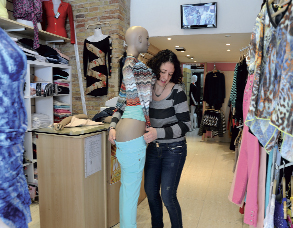Barcelona has fewer inhabitants than Paris but a similar number of immigrants, hailing from every continent. The city and its surrounds have been very good hosts: this evolution has enriched us all.
A fascinating and little-known corner of Paris is Little Jaffna, crammed full of Sri Lankan businesses. Going down the Rue du Faubourg-Saint-Denis is priceless. But the cultural shock that years ago caused me to take the metro in the French capital or stroll through La Goutte d’Or was mitigated during my most recent visit to the Sinhala quartier. The reason: Barcelona, with fewer inhabitants than Paris and a similar number of immigrants. My city has changed a lot and quickly (it has gone from having 1.9% foreigners registered as residents in 1996 to more than 17% in 2013), creating a mosaic of different ethnicities that is not only limited to a couple of neighbourhoods. In some, though, a tendency to group together is evident. In others where it is not, it could be soon.
The names Rawal and Ravalkistan clearly show which new population predominates in the old Xino. Pakistanis from the Punjab and Kashmir have made it theirs, and they are so many that lots have had to look further afield: Besòs, the neighbouring Poble-sec and Trinitat Vella. The ones that are not unlocking mobiles on Carrer de Sant Pau give four-euro haircuts on Carrer de les Carretes, sit contemplatively on a bench in the Rambla del Raval, or work behind the counter of halal butchers. In Tejidos Orientales (Hospital, 88), they sell saris and salwar kameezes. A bit further up, the Kami Bismillah has a little empire, and a notably excellent kebab shop (Joaquín Costa, 22). There is also an out-of-work locale for phoning home from, and one of the many cake shops displaying gulab jaman and portions of barfi in its windows. There are Pakistani restaurants like the historic Shalimar (Carme, 71) that hide their true origins and declare to all and sundry that they serve “Indian food”. This is not true in the case of the deservedly famous Zeeshan Kebabish (Marquès de Barberà, 26), whose dishes include specialities from Karachi and Lahore: haleem, nihari and karhi pakora. For dessert they bring me ras malai and a mango milkshake served in a glass that looks like it came out of the Ark. “When the people come in, they are at home,” Javed Munir, the owner, tells me. And I believe it: everyone has a happy face and a satisfied belly.
Raval Sud is full of surprises. Without a sound, another community, this time from Bangladesh, has recently moved in. Bengalis have opened greengrocers in Cera and Sant Antoni Abat streets, Spanish bars have remained and there is a mosque, Baba Jalal Shah (Riereta, 16). This and other Muslim places of worship fill up during Friday prayers and on Ramadan, and are easily accessed, provided certain standards are met. There is also the Sikh temple Gurudwara Gurdarshan Sahib (Hospital, 97), where they receive me with a sweet dish (kara parshad) and a poster announcing that you are welcome if “you have not been consuming alcohol, tobacco, drugs and animal flesh” and if “you are not carrying any of these substances in your pockets”. Each April, this is the place the baptism festival’s vaishaki procession begins and ends, which leaves behind it an immense carpet of rose petals.
FilCo, Filipino territory
On Sundays, you should visit the parish of Sant Agustí. In the cathedral of the poor you can hear the morning and evening masses given in Tagalog. On this day, the square is inundated with parishioners who, once they have received the Eucharist, go back to their home turf, known as the Triangle de Ponent (Ronda de Sant Antoni/Joaquim Costa/Riera Alta), rechristened by the Filipinos with the odd name of FilCo. More than four thousand of them live there. Some of these Pacific island natives shop at Filipino Foods (Peu de la Creu, 17) and the Pinoy Fiesta take-away, just in front. Others go to pawnshops, and the youngest demonstrate their skills on the Valldonzella basketball court. Half a dozen taverns cook typical dishes: crispy pata, adobo and pancit. El Tropical (Paloma, 19) is the oldest. A little bit further on, a bakery from 1848, La Valenciana (Paloma, 18), five years ago decided to sell pandesal, monay pinoy and pan de coco, despite the owners being from Xella.
The Philippines were the home to the first Chinese immigrants to Barcelona, whom the city housed in the Pequín shanty towns that have since disappeared. Today around 16 thousand, the majority from Qingtian, live among us. They run charmless bars, bazars and beauty centres; in the surrounds of Carrer de Trafalgar, they compete with the Catalan textile wholesalers, and at night wealthy individuals play mahjong in clandestine saloons. In Bon Pastor and Montigalà (Badalona), there are large estates where Gypsy families sell things at rock bottom prices. And in Fondo (Santa Coloma) and Fort Pienc, small subsistence businesses have been created: driving schools, legal offices, travel agencies and estate agencies. Chinatown in Eixample is getting bigger and bigger: the streets of Alí Bei, Nàpols and Roger de Flor are full of shops with signs bearing Chinese characters: shoe shops, florists, Korean fashion boutiques, photo studios and supermarkets. In Yang Kuang (Passeig de Sant Joan, 12) it is difficult to choose between so many noodles, vegetables, sauces and frozen products. There I find jellyfish, sesame popcorn, dehydrated lychees and pots of mango in syrup. And the Panda Decoración ironmongers (Passeig de Sant Joan, 10) is the dream of every handyman. At all hours of the day and night, the restaurant Chen Ji (Alí Bei, 65) is packed with Asians and locals alike: I can confirm that they make magnificent guo tie dumplings.

© Montse García
A supermarket stocking major Latin American products at one end of Carrer de Trafalgar.
Colombians make their presence felt in the Eixample
The Eixample is not in everyone’s reach, but while they can, the Colombians have decided to make an impact. Many have moved into one of the most important tourist neighbourhoods, Sagrada Família, and many others flock there with empty stomachs. A must is a visit to Colombia Pan (Rosselló, 396), the bakery of a Catalan who fell in love with the South American country and where it is customary to breakfast on pandebono, brazos de reina stuffed with the sweet, caramelised arequipe or slice of torta negra. Two hours later there are clients who, incomprehensibly, are hungry again, and will order a gargantuan bandeja paisa in one of the Colombian restaurants that proliferate near the church. The Fonda Paisa on the ground floor of Casa Planells (Diagonal, 332) is, surely, the most authentic. “We eat to excess, but the girls just get surgery and fix it. And if not, they corset themselves up,” admits a shop assistant from Jeans (Lepant, 293), who is sick of selling corsets and levantacolas, buttock-emphasising jeans, to Colombian ladies. Areperías, Latino supermarkets, hairdressers and dental clinics are also cropping up on the streets of Lepant and Cartagena.
The Dominicans, who have been forced to leave Santa Caterina, are now abandoning a fashionable street, Blai, in Poble-sec. The Caribbeans are emigrating to L’Hospitalet, previously reached by the Equatorians and Bolivians, in neighbourhoods that are little different from those of Cochabamba and Guayaquil (La Torrassa, La Florida, Collblanc), full of salteñería bakeries selling the savoury Bolivian pastries. In Barcelona, the Bolivian Consulate’s move to near Urquinaona has given new life to the businesses. While I eat a sopa de maní, amid Quechua faces in a hidden room in a big supermarket, I go over the list of discoveries still to be made: the Romanian businesses near La Model, Little Armenia in Prosperitat, Porta and Trinitat Nova, the dwellings of the Nigeria and Ghana natives in the northern district… And I realise that the city and its surrounds have proved to be very good hosts. The result is, we have all been enriched. And nothing can stop it.





